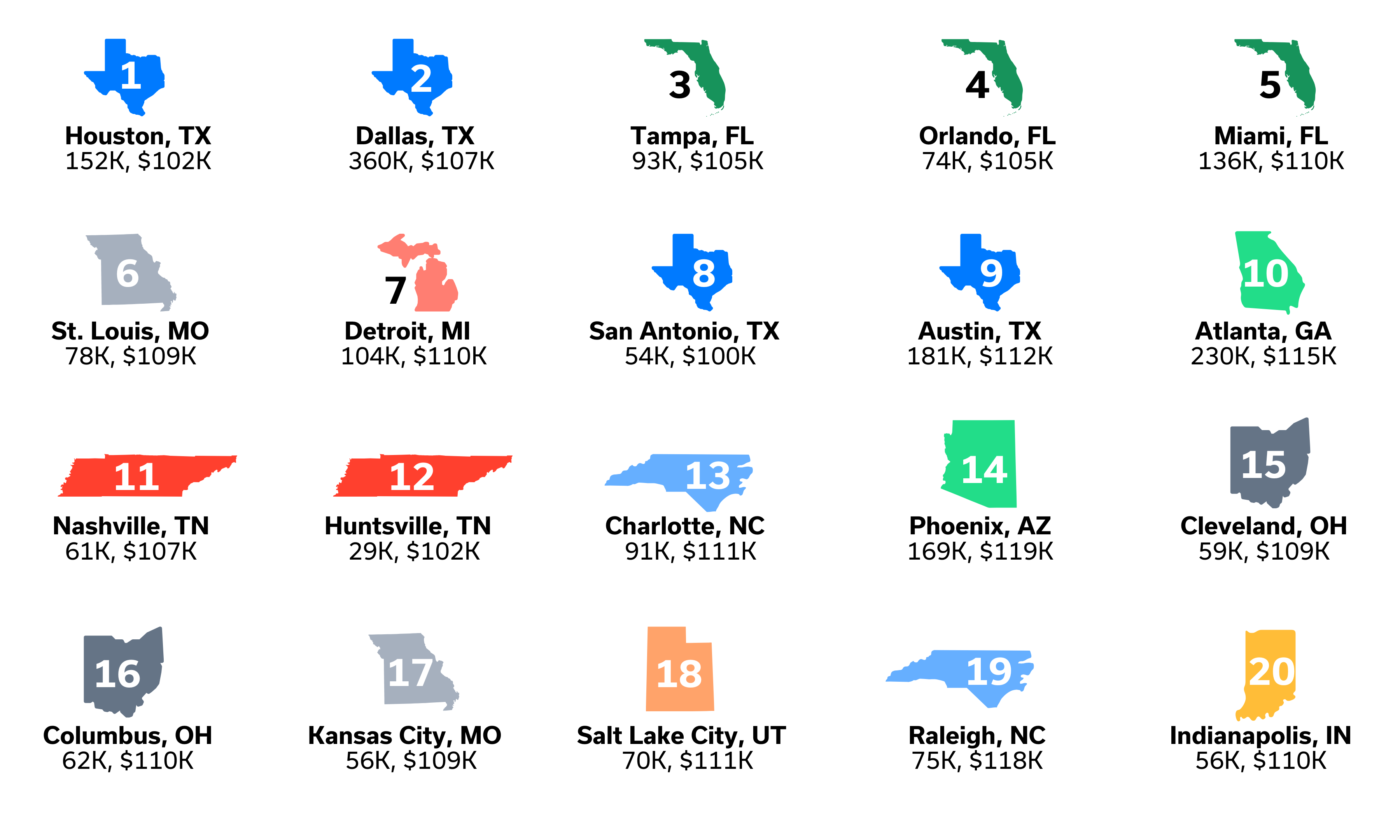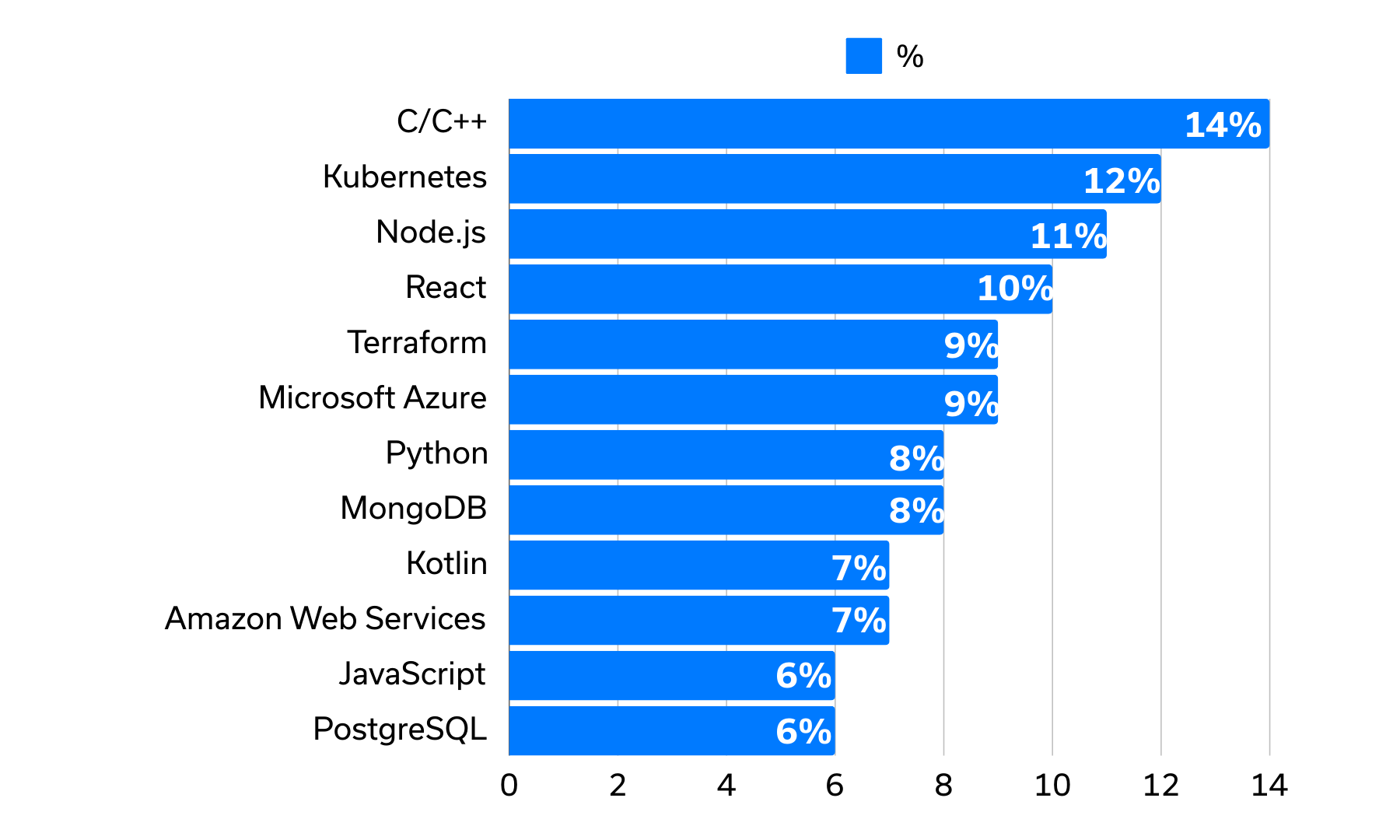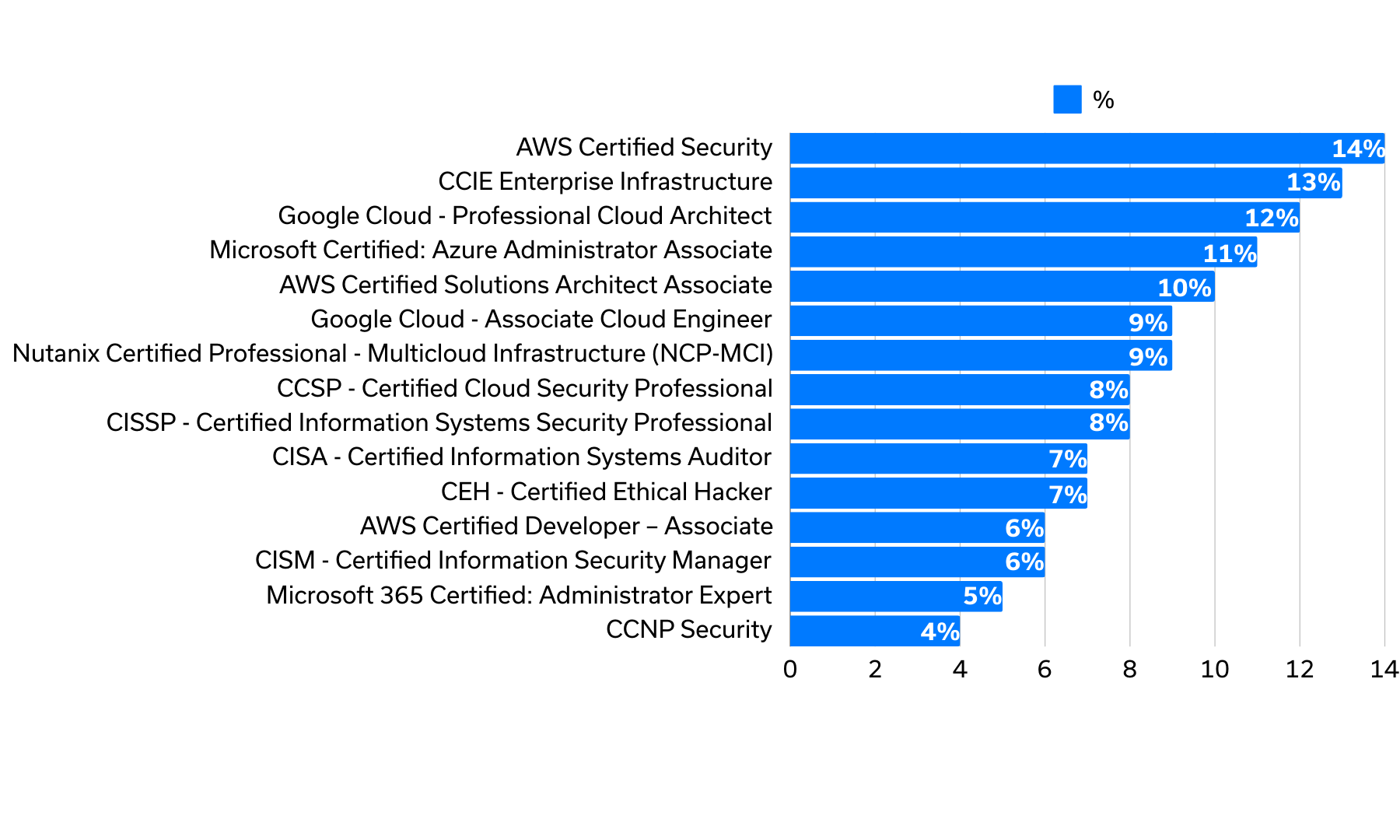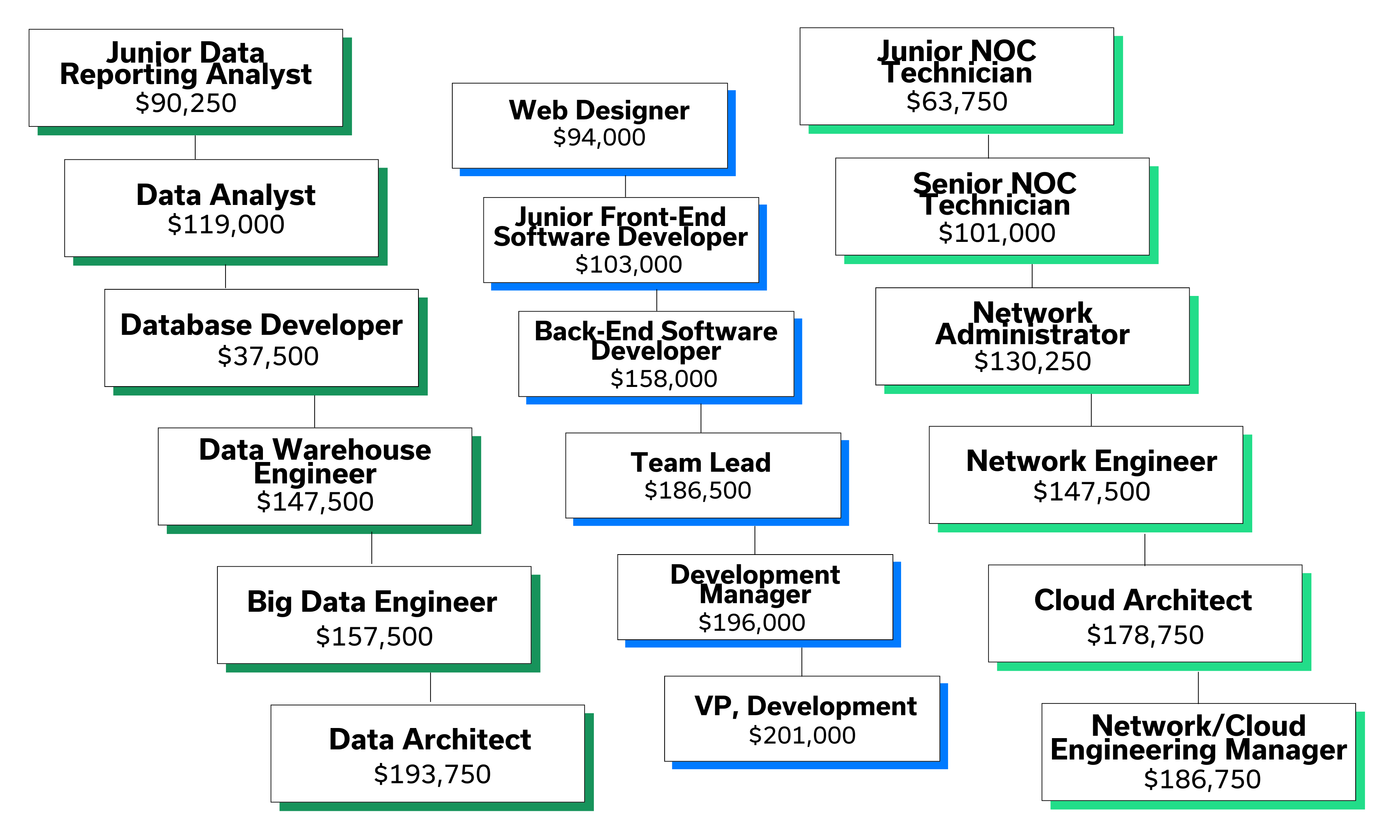2025 Technology Salary Guide
Discover what’s driving the evolving balance of power in tech hiring —

Navigate the Guide
The Tech Job Market’s Next Phase
The technology job market has experienced a whirlwind of change this decade. The balance of power has officially shifted —we are in the midst of an employer’s bull market. This power shift stems from the surplus of technology job seekers weighed against a lower demand for new hires. Since 2020, the industry has experienced significant fluctuations, moving from the Great Resignation to what many now call the Great Retention. Many technologists are choosing to remain in their current roles, benefiting from recently earned perks. Yet, an unexpected twist in this candidate-rich market has been the challenge organizations face in finding qualified tech talent.
Despite tech industry layoffs, finding candidates with niche, in-demand skills remain a challenge. Even with these challenges, there is optimism for an improved candidate market. Tech unemployment has dropped to around 2.5%⁽¹⁾, and recent U.S. Bureau of Labor Statistics (BLS) data highlights growth in key subsectors, including cloud infrastructure, data processing and hosting, and custom software development. As the market began stabilizing in the second half of 2024, questions remain about the potential for steady tech employment growth in 2025. This guide explores the factors and trends shaping the IT landscape, empowering job seekers and hiring managers to make informed decisions.
The Tech Scene at a Glance
The Tech Layoff Effect
Since 2022, over 230,000 layoffs annually have been reported, making up 4.1% of tech employment.⁽²⁾
2024 Retrospective + Looking Ahead to 2025

Reflecting in 2024
The technology job market faced significant challenges, with job openings falling to a 3-year low and resulting in a net loss of 18,100 positions.⁽⁵⁾
Saturated with recently laid-off technologists, the market had more candidates than available jobs and job seeker confidence hit a two-year low in Q3 2024, Many organizations struggled to manage fraudulent applications, ghost job postings, and complications from AI-driven resume filtering systems, frustrating candidates and recruiters alike.
Market stabilization was supported by the Federal Reserve’s decision to cut interest rates in September, which spurred new job openings in specific sectors. By the end of 2024, there were over 200,000 open tech positions at startups, tech unicorns, and public tech companies.⁽⁶⁾
Remote opportunities continued to decline, with only 20% of listings offering hybrid or remote work options, despite strong interest from job seekers.⁽⁷⁾
Salary growth remained stagnant at 3.5%, mirroring 2023 levels, leaving job seekers cautiously optimistic yet concerned about wage trends.
Despite layoffs, demand for niche skills in Cloud, Cybersecurity, DevOps, and AI remained steady, with recruiters inundated by applications for specialized roles.

Anticipating 2025
The U.S. job market is forecasted to experience a renewed slowdown through 2025, but the technology job market is expected to show modest growth.
13% growth expected through 2026: Employment in computer science and IT is projected to outpace the average for all occupations.⁽⁸⁾
High-demand roles: Network Architects, Security Analysts, Data Scientists, and Software Developers are expected to see faster-than-average growth rates through 2032.
BridgeView estimates that IT job roles will increase by approximately 7% in 2025.
Concerns about AI eliminating tech jobs often focus on large companies like Google and Meta, which have announced layoffs after developing AI tools. However, there's no clear evidence linking AI to widespread tech job loss. In fact, AI is expected to drive economic transformation, creating new roles and spurring long-term tech hiring growth. While some positions, such as customer support and lower-level development roles, may be phased out, new opportunities will emerge to bridge human expertise with AI capabilities.
To address this rising demand, the IT workforce in the United States is projected to grow at twice the rate of the overall workforce over the next decade.
National Tech Scene
Several new trends are shaping both corporate hiring strategies and candidate preferences. From regional salary dynamics and AI-driven recruitment tools to technologists prioritizing stability and certifications driving salary boosts, these insights reveal the forces defining today’s tech talent market.
Employer Trends
#1 - Top US Cities to Hire Remote Tech Employees
BridgeView analyzed all major US metro areas with the highest tech employment, with areas that have the most affordable cost of living, to identify the best location values to hire remote technologists. Rankings are based on net tech employment and living wages for a family of four.
Data points from CompTIA Research⁽⁹⁾and MIT Living Wage Calculator.⁽¹⁰⁾
Key = Tech Employment (152k in Houston, TX), Cost of Living ($102k in Houston, TX).

#2 - Which Tech Skills Will Cost the Most?
BridgeView analyzed most in-demand technologies and estimated the premium associated with expertise in these skills. Here are the top technologies and their expected pay increases compared to traditional counterparts.
Data points from: StackOverflow, ZipRecruiter, and internal compensation data.

#3 - From the Great Resignation to the Great Retention
During the peak of the Great Resignation in 2021, the tech industry's quits rate reached 2.2% per month. By late 2024, this dropped to 1.0%, as technologists increasingly chose stability.
This decline resulted from several factors, including over 150,000 layoffs, the rise of AI, increased outsourcing, offshoring, and overall market uncertainty. Additionally, companies implemented a range of perks and incentives to retain talent, such as:
• Remote and hybrid work options: Greater flexibility and work-life balance with work-from-home or split schedules.
• Flexible schedules: Employees can structure their workdays around personal and professional commitments.
• Enhanced benefits packages: Improved health, wellness, and financial perks, with significant 401K growth in a strong stock market.
• Opportunities for promotion: Clearer career paths and growth opportunities to encourage internal advancement
• Upskilling and training programs: Professional development initiatives to keep employees competitive in a rapidly changing industry.
#4 - Integration of AI-Driven Hiring Technology Tools
AI is revolutionizing staffing processes by enhancing candidate selection, streamlining recruitment, and improving verification. While these technologies help manage the influx of applications in a candidate-rich market, they also introduce complexities. Here are the latest trends.
• Bulk Resume Submissions: AI chatbots, “easy apply” platforms, and one-click applications enable candidates to apply at scale, often requiring about 120 applications to land a job. Tools like ChatGPT help candidates tailor resumes, making it harder for recruiters to gauge authenticity.
• AI Resume Screening: With corporate tech job postings receiving 250–1,000+ applications, recruiters use tools like resume parsers, enrichers, and AI screening software to sift through high volumes efficiently.
• Technical Assessments: AI-driven testing software now screens candidates early, using tech questions at submission or pre-interview stages. AI proctoring tools ensure fairness and detect cheating in coding challenges or online assessments.
• Anti-Fraud Tools: In the age of remote work, employers are increasingly concerned about candidate fraud. Advanced technologies such as Generative AI and deepfakes have armed dishonest candidates with new methods to manipulate resumes, mislead during interviews, and even forge identities. Here are some ways BridgeView is using AI tools to combat candidate fraud.
Candidate Trends
#1 - How much is a certification worth?
The demand for specialized tech skills is constantly changing and acquiring the right certifications is a key factor in boosting your earning potential. In 2025, professionals with the following certifications may see notable percentage pay increases compared to traditional counterparts.
Data points from: Skillsoft, and internal compensation data.

#2 - Career Progression Pathways in Tech
Understanding how to advance within the tech industry is crucial for maximizing your salary. The following are common career pathways in software development, data engineering, and networking.

#3 - Tech Contract Roles: A Financial Breakdown
If you are considering a shift from a full-time salaried position to a technology contract role, understanding the financial impact is key. While contract roles offer flexibility, how do they compare financially to the stability and benefits of full-time employment? Here's a breakdown to help you decide.
• Full-Time Salary Package: For a Software Engineer earning $150K annually, the full-time package often includes a 5% bonus, health benefits, 3 weeks of paid vacation, and 8 paid holidays—totaling around $157,500. After health benefits deductions, the net is approximately $156,096, or $75/hour for a 40-hour work week.
• Contract Role Compensation: A similar contract role would pay $85/hour. Without bonuses or employer-sponsored benefits, subsidized benefits might cost $2,820 annually. Contractors work about 1,896 hours annually (excluding 23 paid days off), equating to $161,160. After benefits, the net income is about $158,340.
• The Overtime Edge: Contractors often earn overtime, unlike salaried employees. With tech contractors averaging 43.5 hours weekly, the extra 3.5 hours could add $14,130 annually.
• The Bottom Line: Full-time roles average $156K annually, while contractors might earn $172K—a $16K difference that can provide added financial freedom or time off between projects.
#4 - Negotiating Tech Salaries
One of the most critical aspects of ensuring you are paid your worth is negotiating your salary effectively. Here are expert tips for salary negotiation:
• Know Your Market Value: Research salary trends using resources like BridgeView's Salary Guide and platforms like PayScale or Glassdoor. Use this data to identify the appropriate salary range for your role and location.
• Leverage Pay Transparency Laws: Many companies must disclose the salary range in their job postings. Understanding this range from the start helps you effectively position your desired salary. Regions like California, Colorado, and New York have such requirements, with Maryland poised to join them.
• Don’t disclose current/past salaries if not required: You are no longer required to disclose your current or past salary in many places due to salary history bans. Keeping this information private is your right, with 17 states and various localities enforcing such bans.
• Highlight Certifications and Specialized Skills: Employers are willing to pay more for professionals with certifications in fields like networking, cybersecurity, or cloud architecture. Mention your certifications and niche technical skills during negotiations to justify a higher salary.
• Don’t focus just on the base salary: Make sure you consider the entire compensation package including healthcare, retirement plans, vacation time, PTO, stock options, and profit sharing.
Salaries by Job Title
Data Key:
Low: Median base salary for junior level candidates with 0-3 years of job specific experience
Mid: Median base salary for mid-level candidates with 4-9 years of job specific experience
High: Median base salary for senior level candidates with 10+ years of job specific experience
| Job Title | Low | Mid | High | Category |
|---|---|---|---|---|
| Agile Coach Guides teams in adopting Agile practices, fostering collaboration, and improving delivery efficiency. | $127,500 | $145,000 | $167,500 | Project Management & SDLC |
| Applications Security Engineer Secures application development processes, mitigating vulnerabilities and risks. | $128,500 | $158,000 | $187,500 | Security |
| Applications Support Analyst Supports application performance by troubleshooting and resolving user-reported issues. | $53,750 | $86,250 | $109,000 | Operations & Support |
| Artificial Intelligence/Machine Learning Engineer Designs AI/ML algorithms to analyze data, automate tasks, and provide predictive insights. | $124,750 | $167,000 | $193,750 | Software & Application Development |
| Automated Test Engineer Develops and executes automated test scripts, ensuring consistent and efficient quality assurance. | $108,750 | $124,000 | $150,250 | Software & Application Development |
| Back-End Software Developer Builds server-side applications, ensuring robust functionality and seamless integration with front-end systems. | $116,500 | $158,000 | $185,000 | Software & Application Development |
| Big Data Engineer Builds systems for processing and analyzing vast datasets, enabling real-time decision-making. | $127,500 | $157,500 | $182,500 | Data & Analytics |
| Business Analyst Analyzes business needs, translating them into actionable requirements for technical teams. | $99,500 | $125,500 | $149,750 | Project Management & SDLC |
| Business Intelligence Analyst Transforms data into actionable insights through visualization and reporting tools. | $102,750 | $138,000 | $163,250 | Data & Analytics |
| Chief Information Officer (CIO) Defines IT strategy to align technology initiatives with business objectives. | $205,000 | $256,500 | $313,500 | Executive |
| Chief Information Security Officer (CISO) Leads organizational cybersecurity efforts, safeguarding assets against evolving threats. | $186,000 | $242,000 | $274,500 | Executive |
| Chief Technology Officer (CTO) Drives innovation by overseeing technology strategy and development. | $192,000 | $246,000 | $299,000 | Executive |
| Cloud Administrator Manages cloud platforms, ensuring smooth operations and resource optimization. | $114,000 | $137,250 | $152,500 | Networking & Cloud |
| Cloud Architect Designs cloud infrastructure, enabling scalable and secure services. | $151,250 | $178,750 | $202,000 | Networking & Cloud |
| Cloud Engineer Builds and maintains cloud environments to support business operations and innovation. | $133,500 | $154,000 | $182,500 | Networking & Cloud |
| Cloud Security Engineer Ensures the security of cloud environments, protecting data and applications. | $133,500 | $161,000 | $195,000 | Security |
| Data Analyst Examines data to identify patterns and support informed business decisions. | $93,750 | $119,000 | $140,000 | Data & Analytics |
| Data Architect Designs data infrastructure to support organizational analytics and business intelligence needs. | $140,750 | $168,000 | $193,750 | Data & Analytics |
| Data Reporting Analyst Generates detailed reports from data, supporting organizational strategy and performance evaluation. | $90,250 | $114,250 | $133,750 | Data & Analytics |
| Data Scientist Analyzes complex data sets to uncover trends and provide actionable insights. | $113,000 | $148,500 | $187,500 | Data & Analytics |
| Data Warehouse Engineer Develops and maintains data warehouses, ensuring efficient storage and retrieval of large datasets. | $124,000 | $147,500 | $171,000 | Data & Analytics |
| Database Administrator Maintains database environments, ensuring reliability, security, and high availability. | $101,250 | $134,750 | $149,250 | Data & Analytics |
| Database Developer Creates and optimizes databases to support application functionality and data management. | $98,500 | $137,500 | $151,750 | Data & Analytics |
| Database Manager Manages database systems, ensuring data integrity, security, and optimal performance | $143,000 | $171,000 | $188,000 | Data & Analytics |
| Desktop Support Analyst Resolves end-user hardware and software issues to ensure productivity. | $55,500 | $68,500 | $82,750 | Operations & Support |
| DevOps Engineer Streamlines development and deployment pipelines, ensuring continuous integration and delivery. | $152,250 | $170,500 | $195,500 | Software & Application Development |
| Enterprise Resource Planning (ERP) Analyst Analyzes ERP systems, optimizing workflows and identifying areas for process improvement. | $116,500 | $136,750 | $164,500 | Software & Application Development |
| Enterprise Resource Planning (ERP) Software Developer Builds ERP solutions to integrate business processes, ensuring efficiency and scalability. | $127,000 | $145,000 | $174,500 | Software & Application Development |
| Front-End Software Developer Develops user-facing interfaces, ensuring responsive and visually engaging digital experiences. | $103,000 | $144,000 | $171,000 | Software & Application Development |
| Full-Stack Software Developer Develops both front-end and back-end systems, delivering end-to-end application functionality. | $121,750 | $163,500 | $190,500 | Software & Application Development |
| GRC Analyst Manages governance, risk, and compliance initiatives, ensuring alignment with regulatory requirements. | $94,250 | $119,500 | $139,000 | Security |
| Help Desk Technician Provides first-line IT support for users, resolving technical problems quickly. | $45,250 | $56,250 | $65,500 | Operations & Support |
| Information Security Analyst Monitors systems for security threats, responding to incidents and improving defenses. | $112,000 | $139,500 | $163,250 | Security |
| Information Security Manager Oversees cybersecurity strategy, protecting organizational data and systems from threats. | $153,000 | $178,000 | $207,750 | Security |
| Information Technology Director Oversees IT departments, managing teams and driving technology implementation. | $150,250 | $181,500 | $205,500 | Executive |
| Information Technology Manager Manages IT staff and projects, ensuring operational success and alignment with objectives. | $129,250 | $158,000 | $184,250 | Executive |
| IT Auditor Evaluates IT systems and processes to ensure compliance and identify improvement opportunities. | $82,000 | $109,250 | $138,500 | Operations & Support |
| IT Operations Manager Oversees IT operations, ensuring efficient processes and reliable system performance. | $135,000 | $152,000 | $181,000 | Operations & Support |
| Manual Test Engineer Streamlines development and deployment pipelines, ensuring continuous integration and delivery. | $89,500 | $111,000 | $127,500 | Software & Application Development |
| Mobile Applications Developer Creates mobile apps optimized for performance and usability across various platforms. | $113,000 | $146,500 | $172,000 | Software & Application Development |
| Network Administrator Manages day-to-day network operations, troubleshooting issues and maintaining uptime. | $101,500 | $130,250 | $145,000 | Networking & Cloud |
| Network Architect Designs and optimizes network systems to support business goals and scalability. | $147,000 | $168,250 | $199,500 | Networking & Cloud |
| Network Engineer Configures and maintains network hardware and software to ensure seamless connectivity. | $121,750 | $147,500 | $174,000 | Networking & Cloud |
| Network Security Engineer Implements and maintains network security measures to protect against unauthorized access. | $123,750 | $153,500 | $179,000 | Security |
| Network/Cloud Engineering Manager Oversees network and cloud infrastructure, ensuring secure, efficient connectivity and operations. | $141,500 | $159,500 | $186,750 | Networking & Cloud |
| NOC Technician Monitors network systems to identify and resolve performance or security issues. | $63,750 | $84,000 | $101,000 | Networking & Cloud |
| PC Technician Installs and repairs computer hardware and software for organizational users. | $43,000 | $51,750 | $62,500 | Operations & Support |
| Product Management Director Leads strategic vision and oversees high-level planning to align product goals with business objectives. | $159,500 | $174,000 | $203,000 | Product Management & Design |
| Product Manager Develops and manages product lifecycle, balancing stakeholder needs and market trends for success. | $121,750 | $150,250 | $174,250 | Product Management & Design |
| Product Owner Prioritizes and refines product backlog to ensure development aligns with business and user requirements. | $97,000 | $134,750 | $159,000 | Product Management & Design |
| Program Manager Coordinates multiple interconnected projects, ensuring they collectively meet overarching organizational goals. | $132,250 | $155,500 | $184,750 | Project Management & SDLC |
| Project Coordinator Supports project teams by tracking progress, managing schedules, and maintaining documentation. | $69,500 | $92,250 | $111,000 | Project Management & SDLC |
| Project Management Office (PMO) Manager Oversees project portfolios, ensuring alignment with organizational strategy and efficient resource utilization. | $139,500 | $163,750 | $190,000 | Project Management & SDLC |
| Project Manager Leads individual projects, managing scope, timelines, and resources to deliver successful outcomes. | $112,000 | $148,500 | $176,000 | Project Management & SDLC |
| Scrum Master Facilitates Agile processes, removes blockers, and ensures the team adheres to Scrum principles. | $112,750 | $134,250 | $158,500 | Project Management & SDLC |
| Security Architect Designs secure systems and infrastructure to safeguard against evolving cyber threats. | $150,250 | $179,250 | $202,500 | Security |
| SOC Analyst Identifies and mitigates security threats, supporting Security Operations Center activities. | $89,500 | $111,750 | $131,000 | Security |
| Software Applications Architect Designs software system architecture, ensuring scalability, security, and alignment with business requirements. | $151,500 | $181,500 | $201,750 | Software & Application Development |
| Software Development Manager Leads development teams, ensuring software solutions meet business needs and technical standards. | $145,000 | $178,750 | $196,000 | Software & Application Development |
| Systems Administrator Manages IT systems, ensuring functionality and resolving technical issues. | $93,250 | $127,000 | $146,250 | Operations & Support |
| Systems Engineer Designs and supports IT systems, ensuring integration, reliability, and scalability. | $108,750 | $142,500 | $157,500 | Operations & Support |
| Team Lead Software Developer Manages development teams, balancing coding responsibilities with mentorship and team coordination. | $142,000 | $165,500 | $186,500 | Software & Application Development |
| Technical Writer Produces clear, concise technical documentation, ensuring complex information is accessible to users. | $81,250 | $97,500 | $118,000 | Project Management & SDLC |
| UX Designer Crafts intuitive user interfaces by blending aesthetics and functionality to improve user satisfaction. | $94,000 | $129,000 | $144,000 | Product Management & Design |
| UX Researcher Investigates user behavior to inform design decisions and enhance product usability and engagement. | $91,500 | $116,000 | $132,500 | Product Management & Design |
| VP of Information Technology Directs IT strategy and operations, ensuring alignment with business priorities. | $166,250 | $201,000 | $251,250 | Executive |
Trending Jobs
These six job titles are gaining momentum in 2025, showcasing not only the highest demand but also a scarcity of qualified professionals.
Desktop Support Analyst
• Median Salary: $68,500
• Relevant certifications: CompTIA A+ and Network+, Microsoft Desktop Administrator Associate, HDI Desktop Support Technician, and ITIL Foundations
Applications Security Engineer
• Median Salary: $158,000
• Relevant certifications: Certified Application Security Professional Plus (CASP+), Certified Application Security Engineer (CASE), Certified Information Systems Security Professional (CISSP), Certified Information Security Manager (CISM), and Certified Ethical Hacker (CEH)
Big Data Engineer
• Median Salary: $157,500
• Relevant certifications: Associate Big Data Engineer (ABDE), Google Cloud Professional Data Engineer, AWS Certified Big Data – Specialty, IBM Certified Data Engineer – Big Data, Microsoft Certified Azure Data Engineer Associate
Full-Stack Software Developer
• Median Salary: $163,500
• Relevant certifications: Oracle Certified Professional in Java (OCP), Certified Associate in Python Programming (PCAP), Full Stack Web Developer - MEAN Stack, Certified Professional in Full Stack Development (CP-FSD)
DevOps Engineer
• Median Salary: $170,500
• Relevant certifications: Docker Certified Associate (DCA), Certified Kubernetes Administrator (CKA), AWS Certified DevOps Engineer, and Microsoft Azure DevOps Engineer Expert
Cloud Architect
• Median Salary: $178,750
• Relevant certifications: AWS Certified Solutions Architect, Google Cloud Professional, and Microsoft Azure Solutions Architect Expert
Path Forward
While the Great Retention has stabilized much of the workforce, demand for specialized skills in Cloud, DevOps, AI, and Cybersecurity remains high, creating a paradox in a candidate-rich market. Employers are responding with innovative strategies, including AI-powered tools, hybrid work models, and enhanced retention efforts, while technologists pursue certifications and upskilling to stay competitive. As we look toward 2025, the industry is poised for modest growth, driven by emerging roles and technological advancements that promise to redefine career pathways and recruitment strategies.